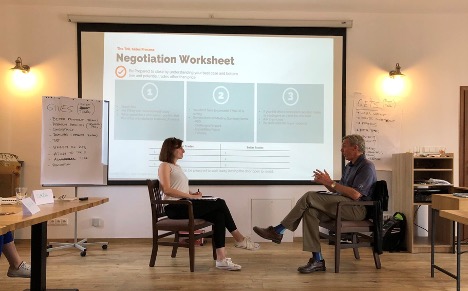If the Buyer Is in the Lead, Your Sales Process Has Fallen Behind
 One day a salesman approached me while I was working in my yard. He was selling house painting services and asked me if I was interested in getting my house painted. I said yes. Then he made a mistake that allowed me to take over and lead the conversation. He began to speak to me as if I were ready to sign on the dotted line. I led him on and he was surprised when he couldn’t close the deal. His error? He mistook my curiosity as motivation to buy what he was selling. This stumble on his part allowed me to gather information I wanted without any real intention of buying.
One day a salesman approached me while I was working in my yard. He was selling house painting services and asked me if I was interested in getting my house painted. I said yes. Then he made a mistake that allowed me to take over and lead the conversation. He began to speak to me as if I were ready to sign on the dotted line. I led him on and he was surprised when he couldn’t close the deal. His error? He mistook my curiosity as motivation to buy what he was selling. This stumble on his part allowed me to gather information I wanted without any real intention of buying.
Although this interaction happened in my front yard, this kind of scenario takes places in all sorts of sales situations as buyers take the lead. And when buyers lead, sellers lose.
How can you teach your salespeople to recognize this kind of buyer? Share with them these three ways buyers manipulate the salesperson and then leave them disappointed when they can’t close the deal:
- Dangling False Carrots. False carrots are statements like “I’m interested, I’m looking for information, I’m having a problem with,” etc. These declarations draw the seller in. The sales person thinks they have a hot lead, but in reality the buyer may only be looking for information. In my case, I’d thought about painting my house, but I wasn’t ready any time soon. I was just curious. I began asking questions just to get information from the seller. I asked questions like, how long does it take, what should I paint, who does the actual painting. I was asking all the questions and he was doing all the talking. Who was in control of the process? I was.
- Asking for Prices First. When the buyer is in control, this question is asked early on. In my example, I was curious how much his great service was going to cost. This guy spent 90 minutes working up a quote. He was satisfying my curiosity. He asked no qualifying questions, and he was giving me information for free. Why wouldn’t I take it? When finished with the quote, he gave me a great presentation as to why I should use his company complete with testimonials from neighbors who’d used their service. It all sounded great and the price seemed fair and reasonable. However, I still wasn’t ready to buy.
- Delaying Rejection. Because I wasn’t ready to commit, I ended the conversation with the dreaded “Let me think about it.” Even though I knew there was a slim chance that I was going to purchase, I couldn’t bring myself to tell him. I thought he was a nice guy and I didn’t want to let him down. Besides, I got what I wanted: a quote. I had something to use as a benchmark for when I would be serious about painting my house, a dollar amount I could use to negotiate a better price with another painter. And he got nothing but a “I’d like to think it over” statement. He wasted a couple of hours chasing a sale that wasn’t going to happen.
He followed up a few days later to be told “no.” I’m sure he was surprised because he didn’t realize his mistake.
Did it have to go this way for him? Not at all. What could he have done differently? He could have managed his defined sales process with checkpoints. A sales process defines what you need to know from the buyer before sharing information or moving to the next step. Without a defined process, the buyer takes over and draws the seller in. The buyer is in the lead and the sales person can’t get that lead back.
If you or your sales people have you ever been told, “I need to think it over,” that’s a sure sign your sales process needs some adjustment.


 We’ve all received questionable sales advice at some point during our careers – some from mentors or managers, some from peers, and sadly some even from training experts and consultants who are paid to know better.
We’ve all received questionable sales advice at some point during our careers – some from mentors or managers, some from peers, and sadly some even from training experts and consultants who are paid to know better.





